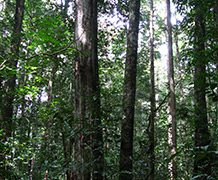
Using a vast dataset of over 500 forest plots and 200,000 trees made up of 3,600 named species, the researchers were able to compare the abundance, biomass stock and woody growth of each species.
One percent of tree species in the Amazon forest account for half of its carbon
Amazon rain forests are the world’s most extensive and are extraordinarily diverse, being home to an estimated 16,000 tree species. Yet a new study published in the journal Nature Communications has discovered that fewer than 200 species of these, barely 1%, are responsible for half of all tree growth and carbon stored in the Amazon.
The study led by RAINFOR, a large network of South American and European researchers, and a tropical forest ecologist from the University of Exeter also shows that the most abundant species do not necessarily store or process the most carbon.
Using a vast dataset of over 500 forest plots and 200,000 trees made up of 3,600 named species, the researchers were able to compare the abundance, biomass stock and woody growth of each species.
Lead author Dr Sophie Fauset, from the School of Geography, University of Leeds, said: “Certain species are already recognized as being especially abundant in the Amazon, but it was unknown whether these actually dominate the forest carbon cycle. We found that while species that are very common often do store a lot of biomass, others store or grow much more than their abundance suggests.”
One such critical species is Bertholletia excelsa, also known for producing Brazil nuts. Less than one in a thousand Amazon trees is a Brazil nut, but it ranks the third most important species in terms of carbon storage and fourth in growth.
Species that are able to reach a large size tend to dominate disproportionately, while much of the diversity in the Amazon is made up of small tree species that live in the forest understory. “Whilst there is less diversity amongst the larger species, they contribute more to certain ecosystem services” said Dr Fauset.
Dr Ted Feldpausch, co-author and a researcher in Geography at the University of Exeter, said: “The concentration of carbon cycling and storage in so few species may provide an advantage in advancing our understanding of how forests across the Amazon Basin process carbon and respond to climate, since we could focus our studies on understanding several hundred rather than thousands of species.”
“However, we still lack substantial information about how these few dominant species may respond to shifts in climate. So few species playing such a disproportionately large role potentially places the Amazon Basin at risk, should those species respond negatively to changes in climate.”
“Trees produce sugars from CO2, sunlight, and water through the process of photosynthesis, and some of these are eventually stored as wood” Dr Michelle Johnson, a co-author of the study, explained. “The Amazon forest helps us out by storing billions of tonnes of carbon that would otherwise remain in the atmosphere contributing to the greenhouse effect.”
In such a large and diverse ecosystem as the Amazon, understanding the carbon cycle is a huge challenge. The finding that just a tiny fraction of species are responsible for half of the biomass could help scientists to predict how the rainforests will fare in a changing climate.
Overlooking the other 99% of species diversity in the Amazon could be dangerous though. Professor Oliver Phillips, co-author of the study cautions, “Our team has worked out which plants ‘matter’ most right now. But, as the Amazon climate continues to change, we may expect a very different set of trees coming to the fore, including some barely noticed now.”
Date: 28 April 2015


